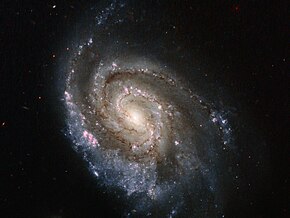NGC 6984
| NGC6984 | |
|---|---|
 NGC 6984 imaged by theHubble Space Telescope | |
| Observation data (J2000epoch) | |
| Constellation | Indus |
| Right ascension | 20h57m53.987s[1] |
| Declination | −51° 52′ 15.13″[1] |
| Redshift | 0.015386[1] |
| Heliocentric radial velocity | 4577 km/s[1] |
| Distance | 180 millionly[2] |
| Apparent magnitude(V) | 12.65[1] |
| Apparent magnitude(B) | 13.19[1] |
| Surface brightness | 22.82 mag/arcsec2[3] |
| magnitude(J) | 10.94[3] |
| magnitude(H) | 10.25[3] |
| magnitude(K) | 9.99[3] |
| Characteristics | |
| Type | Spiral (SAc)[3] |
| Apparent size(V) | 1.403 x 1.038 arcmin[1] |
| Other designations | |
| IRAS20543-5203,2MASXJ20575398-5152151,PGC65798,AM 2054-520, APMBGC 235+046+104, ISOSS J20578-5152, SGC 205419-5203.8, ESO 235- G 020 | |
NGC 6984is abarred spiral galaxylocated 180 million light years away in the constellationIndus.It is a Type IISeyfert galaxy,a type ofActive galactic nucleus(AGN).[4]It is situated south of the celestial equator, and is visible with the help of a telescope having an aperture of 10 inches (250 mm) or more.[3] It was discovered on 8 July 1834 byBritishastronomerJohn Herschel.[5]
Supernovae
[edit]NGC 6984 is notable for having been the host of twosupernovaewhich occurred in the same location (< 0.4 arcsec),[6]about 1 year apart: SN 2012im (typeIc,mag.18.9),[7]first known as SNhunt142,[8][9][10]and SN2013ek (typeIb/c, mag.16.9).[11][12]Hubble Space Telescopeobservations were initiated by Dr. Dan Milisavljevic.[13] NASA's press release about SN 2013ek said:
"It is so close to where SN 2012im was spotted that the two events are thought to be linked; the chance of two completely independent supernovae so close together and of the same class exploding within one year of one another is a very unlikely event. It was initially suggested that SN 2013ek may in fact be SN 2012im flaring up again, but further observations support the idea that they are separate supernovae — although they may be closely related in some as-yet-unknown way."[14]
Gallery
[edit]References
[edit]- ^abcdefg"Search Results for NGC 6984".Astronomical Database.SIMBAD.Retrieved5 November2013.
- ^"Stellar explosions in NGC 6984".ESA/Hubble Picture of the Week.Retrieved5 November2013.
- ^abcdef"NGC 6984 - Spiral Galaxy in Indus".thesky.The Sky LIVE.Retrieved12 Sep2024.
- ^"NGC 6984".simbad.u-strasbg.fr.Retrieved12 Sep2024.
- ^Seligman, Courtney."NGC6984 ".Celestial Atlas.Retrieved22 August2024.
- ^ "SN 2012im/2013ek: A Supernova Double Take in NGC 6984".SAO Astrophysics Data System (ADS).AAS Meeting #223, id.354.29. January 2014.Retrieved12 Sep2024.
- ^"SN2012im ".Transient Name Server.IAU.Retrieved22 August2024.
- ^"ATel #4300: PESSTO spectroscopic classification of optical transients".
- ^"CBET 3607: 20130728: SUPERNOVAE 2012im AND 2013ek IN NGC 6984".Central Bureau for Astronomical Telegrams (CBET).Retrieved12 Sep2024.
- ^"ATel #5225: A new SN suspect at the position of SNhunt142 discovered 1 year ago".
- ^"SN2013ek ".Transient Name Server.IAU.Retrieved22 August2024.
- ^"ATel #5227: Spectroscopic classification for PSN J20575390-5152245 with FLOYDS at Faulkes Telescope South".
- ^"13505 Program Information".
- ^Hubble Catches Stellar Explosions in NGC 6984,NASA,13 November 2013, archived fromthe originalon 21 November 2013
External links
[edit] Media related toNGC 6984at Wikimedia Commons
Media related toNGC 6984at Wikimedia Commons

